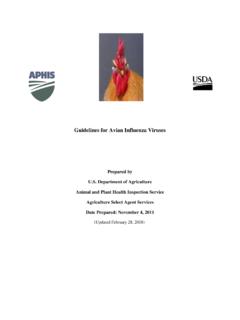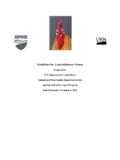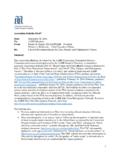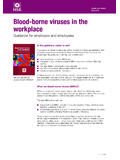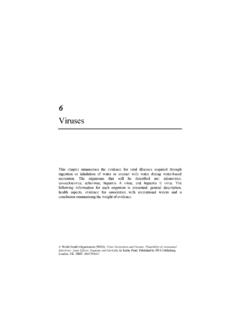Transcription of OptiPrep™ The ideal density gradient medium for ...
1 OptiPrep The ideal density gradient medium for purification and analysis of viruses OptiPrep is a sterile endotoxin tested solution of 60% iodixanol in water with a density of g/ml. Iodixanol was developed as an X-ray contrast me-dium an has therefore been subjected to rigorous clinical testing. Iodixanol is non-ionic, non-toxic to cells and met-abolically inert. Iodixanol solutions can be made iso-osmotic at all useful densities. Iodixanol solutions have low viscosity and osmo-larity OptiPrep is manufactured in compliance with cGMP and ISO 13485 Actual endotoxin levels in each batch are usually measured at < EU/ml. Advantages of OptiPrep based methods Traditionally CsCl or sucrose has been used for the purification of viruses , but iodixanol is now re-placing these media in many virus purification and analytical studies.
2 CsCl and sucrose solution preparation is time-consuming and may require sterilisation before use. Sucrose and CsCl solutions are hyper-osmotic at the densities used to band viruses . The buoyant density of viruses is always much low-er in iodixanol than in CsCl. CsCl in particular leads to major reductions in in-fectivity of most viruses . Virus purified using Opti-Prep gradients shows infectivity:particle number ratios at least 100x those from CsCl gradients. CsCl and sucrose must be removed prior to infec-tion of cells. A protocol for virus purification has been designed to avoid pelleting the virus and to band the virus particles towards the bottom of a self-generated iodixanol gradi-ent while allowing any contaminating membrane materi-al to band at lower densities.
3 The process is simple and requires fewer manipulations than a pre-formed gradi-ent. The figure (upper right) illustrates the method as applied to the purification of Herpes virus. By centrifug-ing at 350,000g for h a steep density gradient profile is generated towards the bottom of the tube and in this part of the gradient the virus bands quite sharply. Any contaminating membranes from the host cells band in the lighter region of the gradient . The small shoulder of infectivity that is observed on the low density side of the virus peak may represent a minor subpopulation of par-ticles and if the intent is to investigate virus morphology and growth rather than simple purification the gradient density profile can be modulated by changing the cen-trifugation time.
4 By decreasing the centrifugation time a shallower region spanning a relatively small density range can be used to advantage to resolve the lighter virus particles from the denser ones (figure lower right). This strategy for virus concentration and purification has also been used successfully by M ller-Larsen and Chris-tensen for the purification of retrovirus from multiple sclerosis patients. The authors found that the particle-friendly iodixanol allowed the recovery of virus which was more functionally competent compared to isolation in sucrose gradients. For detailed protocol and references see Application Sheet V08 at: Purification of viruses in a self-generated gradient Purification of rAAV and parvovirus in pre-formed discontinuous gradients Zolotukhin et al used a four layer discontinuous iodixa-nol gradient (see figure) to purify rAAV from crude cell lysates.
5 Aggregation of rAAV with proteins in the cell lysate can pose a serious problem to its isolation as the aggregates are heterogeneous and consequently exhibit a broad range of densities. Inclusion of 1M NaCl in the 15% iodixanol prevents this aggregation and allows the rAAV to be isolated as a single band in the 40% iodixa-nol layer after centrifugation at 350,000g in a fixed- angle rotor for 1 h. The density of the rAAV in this sys-tem banded at a density > g/ml. All of the contami-nating proteins in the lysate banded at the 25%/40% iodixanol interface and more than 99% of the adenovi-rus contaminant banded at a density of < g/ml. Recovery of infectivity is significantly higher than with CsCl gradients.
6 For detailed protocols and references see Application Sheet V34 at: Dettenhoffer and Yu developed a sedimentation veloci-ty iodixanol gradient to purify HIV-1 virions without affecting the infectivity of the virus. The crude virus suspension is layered over a 6-18% gradient and centri-fuged either 250,000g for h or lower RCFs for long-er times (see figure). The authors constructed the gradi-ent from a multistep discontinuous gradient but the gra-dient is effectively continuous and may therefore be formed using a gradient Master or two-chamber gra-dient maker. In buoyant density sucrose gradients the extra-cellular Vif gene always co-purifies with the virus In sucrose gradients the HIV is contaminated with cell-derived micro vesicles.
7 In iodixanol gradients the HIV-1 is effectively sepa-rated both from Vif and from the micro vesicles. Similar gradients have been used to purify other viruses and the gradients are widely used to study the assembly of these viruses . Purification of HIV-1 virions using a sedimentation velocity gradient A similar method can also be used for parvovirus puri-fication. The strategy has been widely adopted by research workers in gene therapy. For detailed protocols and references see Applica-tion Sheet V14 at: Purification of human papillomavirus using a continuous gradient Cervical cancer is one of the most common cancers in women worldwide. Persistent infection with human papillomavirus (HPV) is considered to be the etiologi-cal factor for cervical cancer.
8 Therefore, an effective vaccine against HPV infections may lead to the control of cervical cancer. An ideal HPV vaccine should aim to generate both humoral immune response to prevent new infections as well as cell-mediated immunity to elimi-nate established infection or HPV-related disease. There are now many published papers that report the use of iodixanol gradients not only to purify viruses but also to investigate their assembly. In all comparative studies between CsCl and iodixanol, the recovery of virus infec-tivity is much higher and the particle:infectivity ratio much lower when viruses are purified in iodixanol. Alt-hough sucrose is generally less deleterious to viral infec-tivity than CsCl, it can nevertheless also have serious effects on certain important aspects of viral function; 15% iodixanol in 1 M NaCl25% iodixanol40% iodixanol60% iodixanolClarified virus fluidproteinsadenovirusrAAV350,000g 1 h6-18% iodixanolin steps250,000g for hHIV1 MicrovesiclesVif genePO Box 6863 Rodelokka N-0504 Oslo Norway Phone: +47 24 05 60 00 Fax: +47 24 05 60 10 Email: or In this leaflet we have presented some of the applica-tions available for the purification of viruses using Opti-Prep.
9 More information can be found on: A L E R E T E C H N O L O G I E S AS Cells collected after transfection is treated with Brij 58 and Benzonase and purified by centrifugation on an OptiPrep step gradient (27, 33, and 39%) at 40,000 rpm for h. Pseudovirus neutralization assays were carried out as outlined previously. Briefly, the pseudo-virus and the pooled mouse immune sera were incubat-ed for 1 h and the mixture was used to infect 293TT cells. 68-72 h post-infection, the supernatants were collected and SEAP activity in the supernatants was measured by colorimetric assay. Serum neutralization titers were defined as the highest dilution that caused at least a 50% reduction in SEAP activity, compared to control pre-immune serum samples.
10 For a detailed protocol and references see Applica-tion Sheet V10 at: Axis-Shield density gradient Media is a brand of Alere Technologies AS in particular the loss of surface glycoproteins from ret-roviruses has been noted. This may be related to its vis-cosity, which, in solutions of the same density , is much higher than that of iodixanol. Like CsCl, sucrose must be dialyzed before infectivity can be measured. In contrast both infectivity measure-ments using cultured cells and many add-on techniques can be performed without dialysis of iodixanol. Com-bined with the availability of OptiPrep as a sterile solution, this makes the use of OptiPrep for virus purification and assembly analysis much more conven-ient than the use of either CsCl or sucrose.





